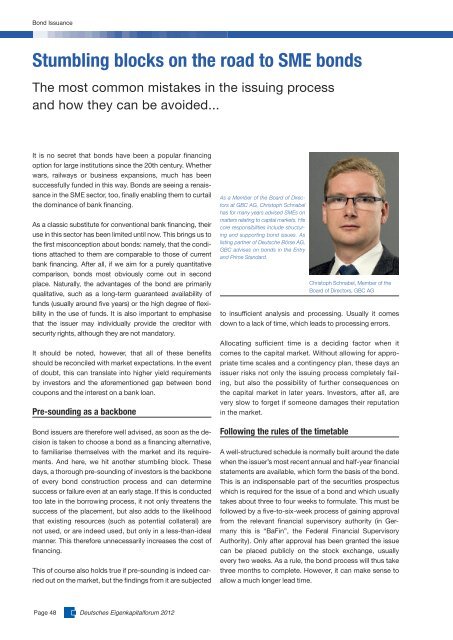Conference Magazine - GoingPublic.de - Deutsches Eigenkapitalforum
Conference Magazine - GoingPublic.de - Deutsches Eigenkapitalforum
Conference Magazine - GoingPublic.de - Deutsches Eigenkapitalforum
You also want an ePaper? Increase the reach of your titles
YUMPU automatically turns print PDFs into web optimized ePapers that Google loves.
Bond Issuance<br />
Stumbling blocks on the road to SME bonds<br />
The most common mistakes in the issuing process<br />
and how they can be avoi<strong>de</strong>d...<br />
It is no secret that bonds have been a popular financing<br />
option for large institutions since the 20th century. Whether<br />
wars, railways or business expansions, much has been<br />
successfully fun<strong>de</strong>d in this way. Bonds are seeing a renaissance<br />
in the SME sector, too, finally enabling them to curtail<br />
the dominance of bank financing.<br />
As a classic substitute for conventional bank financing, their<br />
use in this sector has been limited until now. This brings us to<br />
the first misconception about bonds: namely, that the conditions<br />
attached to them are comparable to those of current<br />
bank financing. After all, if we aim for a purely quantitative<br />
comparison, bonds most obviously come out in second<br />
place. Naturally, the advantages of the bond are primarily<br />
qualitative, such as a long-term guaranteed availability of<br />
funds (usually around five years) or the high <strong>de</strong>gree of flexi -<br />
bility in the use of funds. It is also important to emphasise<br />
that the issuer may individually provi<strong>de</strong> the creditor with<br />
security rights, although they are not mandatory.<br />
It should be noted, however, that all of these benefits<br />
should be reconciled with market expectations. In the event<br />
of doubt, this can translate into higher yield requirements<br />
by investors and the aforementioned gap between bond<br />
coupons and the interest on a bank loan.<br />
Pre-sounding as a backbone<br />
Bond issuers are therefore well advised, as soon as the <strong>de</strong>cision<br />
is taken to choose a bond as a financing alternative,<br />
to familiarise themselves with the market and its requirements.<br />
And here, we hit another stumbling block. These<br />
days, a thorough pre-sounding of investors is the backbone<br />
of every bond construction process and can <strong>de</strong>termine<br />
success or failure even at an early stage. If this is conducted<br />
too late in the borrowing process, it not only threatens the<br />
success of the placement, but also adds to the likelihood<br />
that existing resources (such as potential collateral) are<br />
not used, or are in<strong>de</strong>ed used, but only in a less-than-i<strong>de</strong>al<br />
manner. This therefore unnecessarily increases the cost of<br />
financing.<br />
This of course also holds true if pre-sounding is in<strong>de</strong>ed carried<br />
out on the market, but the findings from it are subjected<br />
Page 48 <strong>Deutsches</strong> <strong>Eigenkapitalforum</strong> 2012<br />
As a Member of the Board of Directors<br />
at GBC AG, Christoph Schnabel<br />
has for many years advised SMEs on<br />
matters relating to capital markets. His<br />
core responsibilities inclu<strong>de</strong> structuring<br />
and supporting bond issues. As<br />
listing partner of Deutsche Börse AG,<br />
GBC advises on bonds in the Entry<br />
and Prime Standard.<br />
to insufficient analysis and processing. Usually it comes<br />
down to a lack of time, which leads to processing errors.<br />
Allocating sufficient time is a <strong>de</strong>ciding factor when it<br />
comes to the capital market. Without allowing for appropriate<br />
time scales and a contingency plan, these days an<br />
issuer risks not only the issuing process completely failing,<br />
but also the possibility of further consequences on<br />
the capital market in later years. Investors, after all, are<br />
very slow to forget if someone damages their reputation<br />
in the market.<br />
Following the rules of the timetable<br />
Christoph Schnabel, Member of the<br />
Board of Directors, GBC AG<br />
A well-structured schedule is normally built around the date<br />
when the issuer’s most recent annual and half-year financial<br />
statements are available, which form the basis of the bond.<br />
This is an indispensable part of the securities prospectus<br />
which is required for the issue of a bond and which usually<br />
takes about three to four weeks to formulate. This must be<br />
followed by a five-to-six-week process of gaining approval<br />
from the relevant financial supervisory authority (in Germany<br />
this is “BaFin”, the Fe<strong>de</strong>ral Financial Supervisory<br />
Authority). Only after approval has been granted the issue<br />
can be placed publicly on the stock exchange, usually<br />
every two weeks. As a rule, the bond process will thus take<br />
three months to complete. However, it can make sense to<br />
allow a much longer lead time.
















